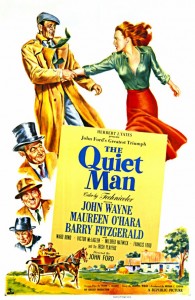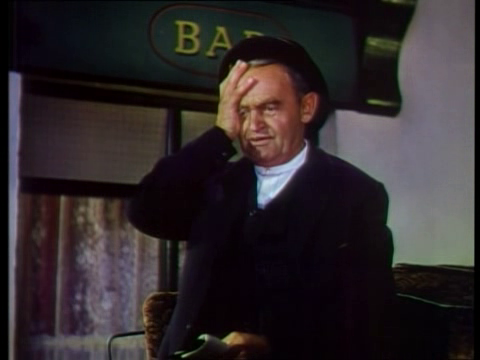Quiet Man, The (1952)
“I’m Sean Thornton and I was born in that little cottage. I’m home, and home I’m going to stay.”
|
Synopsis: |
|
Genres, Themes, Actors, and Directors:
Response to Peary’s Review: In his GFTFF, Peary analyzes the film’s sexual politics, noting that Mary Kate’s refusal to “consummate [her] marriage if she doesn’t have the dowry” makes her like a “modern woman”, given that she “doesn’t want to enter a relationship unless it’s on equal terms”. He writes how refreshing it is that, despite their obvious challenges, Mary Kate and Sean ultimately both view each other with maturity, love, and respect. Mary Kate “decides to have sex with Sean although he has not come through for her”, given that she “senses that he has reasons for not challenging her brother, although she herself may not understand them”. Similarly, Sean “challenges Will for Mary Kate’s sake”, conceding “that her reasons for wanting the dowry are not trivial, although he doesn’t understand them”. Peary goes on to note that “there’s so much Irish humor in this film and so many quirky characters that one tends to overlook that just below the surface there is much seriousness, hurt, and guilt; both Sean and Mary Kate are tormented in real ways and we feel for them”. Finally, Peary points out that while “Ford was never known for ‘love scenes’… the silent passage in which Sean and O’Hara hold hands, race for shelter from the sudden rain, and then stop, clutch (he drapes his sweater over her), and kiss as the rain soaks through their clothing is incredibly sexy”; I agree. Wayne and O’Hara are both in top form here, and are indeed — as Peary notes — “one of the screen’s most romantic couples”. In Alternate Oscars, Peary names Wayne Best Actor of the Year for The Quiet Man, and provides a detailed analysis of why this performance was one of Wayne’s best and “most relaxed”. He notes that Sean “is Wayne’s gentlest character”, that he’s “formidable” but without McLaglen’s “need to be a bully or braggart”. As Peary writes, “He has such confidence in his masculinity that he is polite, emotional, sentimental, and sweet enough to plant roses”, never “hid[ing] his love from Mary Kate, [and] never assum[ing] a paternal or authoritarian stance with her”. Indeed, it’s easy to see why O’Hara would fall in love with him — though naturally, she’s equally appealing, for her own reasons. This romantic couple is one we truly enjoy watching on screen. Redeeming Qualities and Moments:
Must See? Categories
(Listed in 1001 Movies You Must See Before You Die) Links: |







3 thoughts on “Quiet Man, The (1952)”
I would like to recommend a 2010 documentary from Ireland called “Dreaming the Quiet Man”. It delves quite a bit into the social and mythical history that informed Ford’s vision.
Thank you, Caftanwoman! I hadn’t heard of this documentary but will certainly seek it out. It doesn’t seem to be available on Netflix yet…
A once-must, at least, for its place in cinema history, the wonderfully memorable ensemble acting – and as one of Ford’s best films.
Before last night, it had been decades since I’d seen this. It’s a perfectly respectable classic and there are many things I admire about it: it obviously stands out in Ford’s body of work as something set apart; it’s a film that’s very easy to love because it’s so engaging; as a love story, it’s quite unique and it’s intriguing watching how the two main characters will finally break through to each other in solid fashion. Even if it’s not among my favorite films, or one I would feel drawn to return to from time to time (obviously), it’s still a very admirable piece of work.
As well…even though Wayne has no overwhelming appeal for me, he turns in a refreshingly different kind of performance – mainly noticeable because this isn’t a western or a war film. And having recently rewatched O’Hara in ‘How Green Was My Valley’ – where she is considerably subdued – it’s kind of a joy to see her rather amusing version of a bad-tempered woman. …Fitzgerald is especially good in this. I like when he tosses in some of his throw-away deliveries (i.e., when he disdainfully acknowledges: “America. …Prohibition.”; practically shuddering at the thought).
For me, one of the film’s best moments comes late: when we are suddenly shown the episode in Wayne’s past that he has tried to keep from people. And there’s no denying that the sudden trysting in the rain between Wayne and O’Hara (a logical follow-up to the passionate first kiss earlier on – in the eye of the wind!) offers a kind of unbridled sex not really found elsewhere in a Ford film.
By the way…the Blu-ray edition of this film is stunning! Absolutely stunning! Sharp, crisp, COLORful – very much emphasizing the fact that the film is very deserving of its Oscar win for cinematography. (The DVD also contains an informative extra about the ‘Making of…’.)